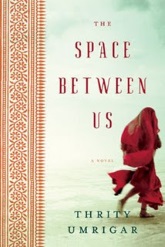The Space Between Us
Thrity Umrigar
|
|
In many ways, Bombay-born writer Thrity Umrigar’s second novel covers common literary terrain. Its theme is familiar: Two characters from opposite sides of the track become inextricably intertwined. Its literary devices aren’t unique: Metaphors and similes appear on nearly every page, and flashbacks reveal characters’ backgrounds. Its characterizations are, on the surface, rife with recognizable dramas: The rich live in luxury, while the poor exist in squalor, and there appears to be no in-between. Yet for all the tale’s familiarity, to read it is to become absorbed in the goings-on of two families whose habits may be startlingly like our own, despite their being halfway across the world. And even if “The Space Between Us” does invite comparisons to stories we’ve heard before (for instance “The Kite Runner,” which takes place largely in Afghanistan, near the India of “The Space Between Us,” and also puts together people of different classes), that doesn’t take away from the blunt realism and beauty of Umrigar’s book. Part of what makes “The Space Between Us” so engrossing is its ability to make readers feel empathy for its subjects. Initially, it’s easy to feel for Bhima; she’s a 65-year-old servant living in a Bombay slum with her granddaughter, Maya. Her children and alcoholic husband are either dead or absent, and every cent she earns goes toward Maya’s college education, which she hopes will be their ticket out of poverty. But when Maya gets pregnant, those dreams evaporate and it appears the girl is doomed to repeat her grandmother’s fate. It would be easy to pity poor Bhima, but Umrigar makes us feel something more: understanding. For Bhima is not just hopeless; she’s also human. She feels “hard, merciless … rage” as she watches the shamefully pregnant 17-year-old sleeping peacefully. In another scene, a flashback, Bhima lashes out against her son when she knows he doesn’t deserve it. Umrigar’s ability to give Bhima such a realistic personality is remarkable and one of the book’s high points. Bhima’s wealthy counterpart is her employer, Sera Dubash, a younger, upper-middle-class Parsi housewife. Like her servant, Sera has carried on without a husband (she is a widow) and has a young woman to watch over (her daughter, Dinaz, and Dinaz’s handsome husband, Viraf, are expecting their first child). But unlike Maya’s pregnancy, Dinaz’s is a happy one — just one of the book’s examples of how members of different classes experience similar circumstances. Every day when Bhima goes to work at Sera’s house she must listen to the family cooing over Dinaz’s growing belly. Yet it’s difficult for her to begrudge them, as Sera, a generous employer who objects to India’s strict class distinctions, uses her clout to bring Maya to a private abortion clinic rather than allow the girl to go to a dirty, public one. Bhima feels nothing but appreciation for Sera and her family, although the book’s denouement later finds her in a horrid struggle with her beloved boss. As Umrigar relates the present and past events in the lives of Bhima and Sera, she reaches for similes and metaphors to describe feelings and actions. Her frequent use of them could become grating if they didn’t color her scenes with such intense, convincing descriptions of Indian life. Sera’s memory of her husband’s death still stings years later, “as if someone sprinkled chili powder in my eyes.” Revealing a terrible secret about one character allows Bhima to “destroy [that person’s] current happiness as swiftly as a wind can knock down a house.” And when the uneducated Bhima learns that the AIDS virus can be in one’s body for years before manifesting itself, she likens the sickness to a curse: “Someone does some jadoo on you — like they put cut fingernails under your mattress or they hide chilis and lime in an old rag and put it in your path — and years go by and you think you are safe. And then one day, something bad happens and you realize that the curse was with you all these years.” Such devices render lifelike the characters’ predicaments, while drawing Western readers into a far-away culture. To read these comparisons is to understand that Umrigar’s Bombay is a place where robust foods figure prominently, elements like wind and sea are driving forces, and religious beliefs underscore everything. She takes the cultural infusion one step further with her use of slang in dialogue. “What is this, baba? So-so much money,” Bhima’s son remarks upon seeing the payoff Bhima’s husband received when he injured himself at his factory job. “Ae, Bhima mausi,” one of Bhima’s slum neighbors calls out from the water tap line, “Come over here, na. For you only I’ve been holding a reservation here.” These singsong phrases steep the narrative in local flavor. To read Umrigar’s novel is to catch a glimpse of a foreign culture, for better and for worse. Yet while the class divide between Bhima and Sera provides much of the conflict in “The Space Between Us,” it isn’t the only source of disagreement. Class colors everything, but in the end, Umrigar shows, every one of life’s ups and downs are available to us all. Lynn Andriani Published | 1 January 2006 | SFGate Reviews
The Clash of Caste | Ligaya Mishan | NY Times Aamer Hussein | Independent Frances Itani | Washington Post
|


 Thrity Umrigar
Thrity Umrigar